Acapulco Damselfish, Stegastes acapulcoensis
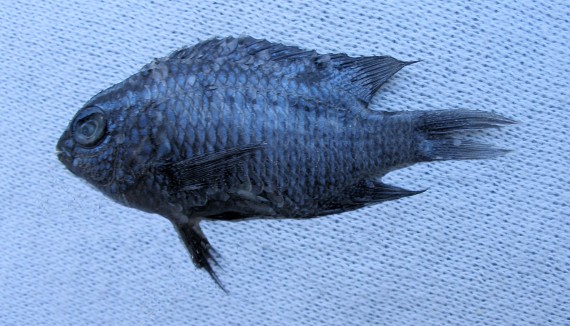 Acapulco Damselfish, Stegastes acapulcoensis, Juvenile. Fish provided by the commercial fishermen of the greater Los Cabos area, Baja California Sur, December 2011. Length: 6.2 cm (2.4 inches).
Acapulco Damselfish, Stegastes acapulcoensis, Juvenile. Fish provided by the commercial fishermen of the greater Los Cabos area, Baja California Sur, December 2011. Length: 6.2 cm (2.4 inches).
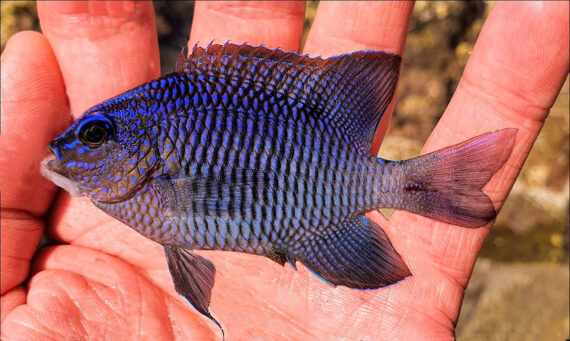 Acapulco Damselfish, Stegastes acapulcoensis, Juvenile. Fish caught from coastal waters off Mazatlán, Sinaloa, October 2021. Length: 7.7 cm (3.0 inches). Catch, photograph and identification courtesy of Bart, The Netherlands (worldangler.eu).
Acapulco Damselfish, Stegastes acapulcoensis, Juvenile. Fish caught from coastal waters off Mazatlán, Sinaloa, October 2021. Length: 7.7 cm (3.0 inches). Catch, photograph and identification courtesy of Bart, The Netherlands (worldangler.eu).
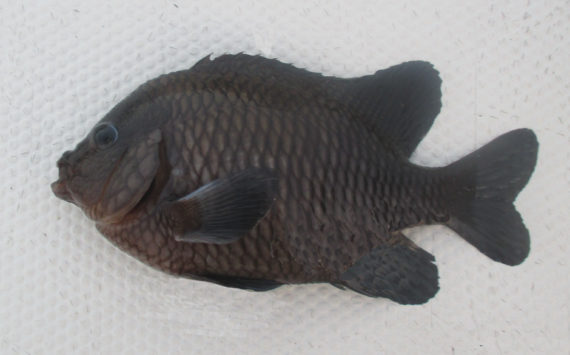 Acapulco Damselfish, Stegastes acapulcoensis. Fish caught from coastal waters off Mazatlán, Sinaloa, October 2017. Length: 12.5 cm (5.0 inches). Catch, photograph and identification courtesy of George Brinkman, Guelph, Ontario, Canada.
Acapulco Damselfish, Stegastes acapulcoensis. Fish caught from coastal waters off Mazatlán, Sinaloa, October 2017. Length: 12.5 cm (5.0 inches). Catch, photograph and identification courtesy of George Brinkman, Guelph, Ontario, Canada.
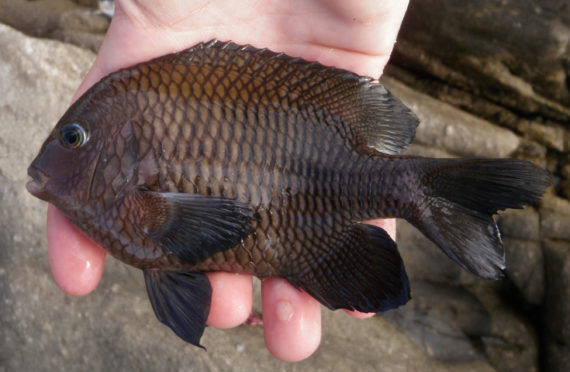 Acapulco Damselfish, Stegastes acapulcoensis. Fish caught from coastal waters off Puerto Escondido, Oaxaca, October 2009. Length: 15.0 cm (5.9 inches). Catch, photograph and identification courtesy of Josh Leisen (joshadventures.com), Gaylord, Michigan.
Acapulco Damselfish, Stegastes acapulcoensis. Fish caught from coastal waters off Puerto Escondido, Oaxaca, October 2009. Length: 15.0 cm (5.9 inches). Catch, photograph and identification courtesy of Josh Leisen (joshadventures.com), Gaylord, Michigan.
 Acapulco Damselfish, Stegastes acapulcoensis. Underwater photograph taken in coastal waters of Bahia Tenacatita, Jalisco. Photograph and identification courtesy of Jeff Cross, Albuquerque, New Mexico.
Acapulco Damselfish, Stegastes acapulcoensis. Underwater photograph taken in coastal waters of Bahia Tenacatita, Jalisco. Photograph and identification courtesy of Jeff Cross, Albuquerque, New Mexico.
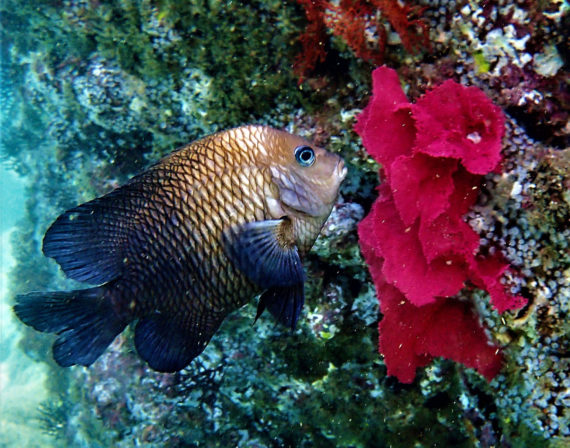
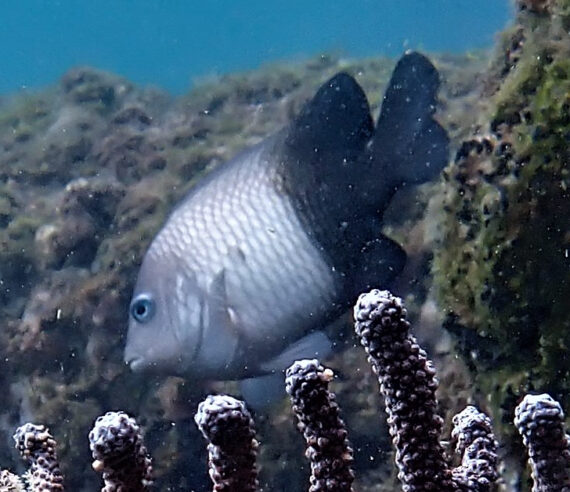 Acapulco Damselfish, Stegastes acapulcoensis. Underwater photographs taken in Zihuantanejo Bay, Guerrero, March 2019. Photographs courtesy of Ron Woheau, Zihuantanejo.
Acapulco Damselfish, Stegastes acapulcoensis. Underwater photographs taken in Zihuantanejo Bay, Guerrero, March 2019. Photographs courtesy of Ron Woheau, Zihuantanejo.
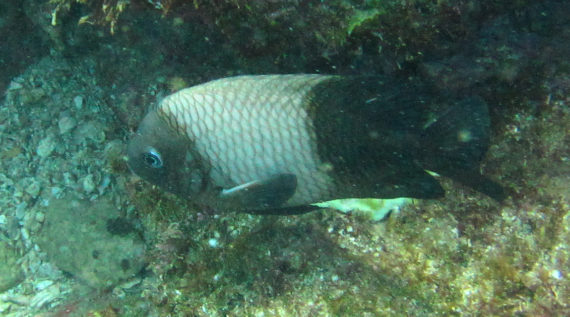 Acapulco Damselfish, Stegastes acapulcoensis. Underwater photograph taken in coastal waters of the greater Los Cabos area, Baja California Sur, October 2019. Photograph courtesy of Bob Hillis, Ivins, Utah.
Acapulco Damselfish, Stegastes acapulcoensis. Underwater photograph taken in coastal waters of the greater Los Cabos area, Baja California Sur, October 2019. Photograph courtesy of Bob Hillis, Ivins, Utah.
The Acapulco Damselfish, Stegastes acapulcoensis, is a member of the Damselfish or Pomacentridae Family, that is also known as Acapulco Major and in Mexico as jaqueta acapulqueña. Globally, there are forty species in the genus Stegastes, of which eleven are found in Mexican waters, seven in the Atlantic and four in the Pacific Ocean.
The Acapulco Damselfish has an oval compressed body with a depth that is 42% to 46% of standard length, thus similar in nature to freshwater bluegills. Adults are gray-brown and lighter on the head and front half of the body. The scales have black margins and the pectoral fins have a prominent white spot at the base. Juveniles are bright blue with a prominent ocellus at the base of the soft dorsal fin and an ocellated black spot on the dorsal edge of the caudal peduncle. The head has a small protrusible mouth that opens in the front with a single row of long and closely set teeth. The gill covers are serrated. The anal fin has 2 spines and 13 rays; the caudal fin is bluntly forked; the dorsal fin is singular and continuous with 12 spines and 15 or 16 rays; and, the pectoral fins have 20 to 23 rays. They have 17 to 21 long and close-set gill rakers on the lower arch. The body is covered with large rough scales. The lateral line is incomplete and ends under the edge of the dorsal fin base.
The Acapulco Damselfish is found in shallow rocky areas within the surge zone at depths up to 17 m (55 feet). They reach a maximum of 18.0 cm (7.1 inches) in length. They are diurnal feeders consuming primarily algae, benthic invertebrates and plankton. They are very aggressive when feeding or when defending their territory. Reproduction is oviparous with pairing of individuals; sticky eggs are distributed demersal and adhere to the substrate. The Acapulco Damselfish is poorly studied with very limited information available about their lifestyle and behavioral patterns including specific details on age, growth, longevity, movement patterns, diet, habitat use, and reproduction.
The Acapulco Damselfish is a resident of Mexican waters of the Pacific Ocean but has a limited and poorly documented range being reported in coastal waters off Baja California Sur from along the east coast from Loreto, south to the East Cape, along the southwest coast of the Baja in the Pacific (as documented by the fish photographed above), and from Mazatlán, Sinaloa, southward along the coast of the mainland to Guatemala.
The Acapulco Damselfish is most likely to be confused with the Cortez Damselfish, Stegastes rectifraenum (uniform reddish brown color) and the Giant Damselfish, Microspathodon dorsalis (extended, elongated, and pointed anal and dorsal fins).
From a conservation perspective the Acapulco Damselfish is currently considered to be of Least Concern with stable, widely distributed populations. They are small in stature and of limited interest to most. They are classic nibblers, and difficult to catch via hook and line.